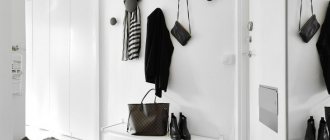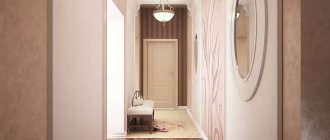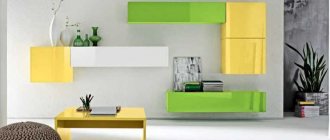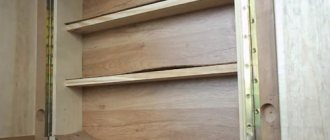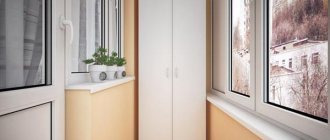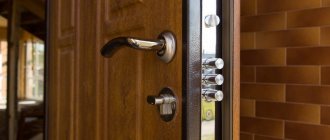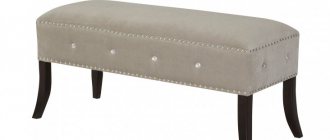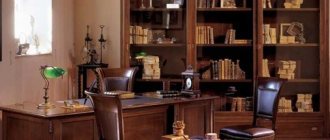15361
As practice shows, modular furniture for the hallway combines constructivism, comfort and aesthetic appeal. It allows you to rationally plan the space, even if the hallway is narrow or has a very limited area. It is for these reasons that such furniture has been so popular in recent years. Let's talk about how to choose a successful modular hallway for your home, and what to pay attention to when doing so.
Advantages and disadvantages
A modular hallway is a real dream for design lovers, because it is a set of assorted elements that can be installed in any order. Thus, it will be possible to choose options that are suitable for a particular home and meet the tastes of the owners. Modular systems have their advantages and disadvantages.
Advantages of modular furniture:
- mobility – it’s easy to rearrange the modular “block” due to its moderate weight;
- the opportunity to feel like a real interior designer;
- compactness – when transporting, you can especially notice how much easier it is to carry one module than a whole closet or sofa;
- quite reasonable cost compared to custom-made headsets.
Minuses:
- limited standard sizes - when purchasing this option for the hallway, you should be prepared for this moment in advance;
- The simplicity of the lines of modular systems will not be to everyone’s taste, however, this is an inevitable price to pay for the ability to combine blocks in any order.
A significant drawback is that no one will make a separate cabinet according to individual measurements, as this is unprofitable. If necessary, the required item will have to be purchased separately, that is, it will stand out from the general style. Otherwise, such furniture is very convenient for arranging a hallway, as it is characterized by mobility and interchangeability.
Distinctive features
Often the corridor in city apartments of multi-storey buildings is not large in size or has a convenient layout. This significantly complicates the task of selecting comfortable, functional and attractive furniture for such a room. That is, a hallway that would fully satisfy the needs of a large family.
The limited size of the hallway forces designers to actively use its volume when selecting furniture. By the way, modular hallways created using the principles of constructivism are ideally suited for such purposes. This direction of decor involves abandoning large items in favor of sets of small blocks that can be shuffled and installed in the current order. In other words, modular hallways, as in the photo, are an ideal option when choosing furniture for the corridor.
Modular furniture for the corridor is a set of individual modules of different sizes and purposes. Cabinets, bedside tables, shelves can be combined and placed as the home owner wants. This unique furniture set is distinguished by its mobility, interchangeability, comfort, and practicality. Therefore, such furniture opens up enormous opportunities for interior designers to create unique interiors. In addition, the cost of modules is almost always more affordable than the cost of custom-made furniture based on an individual project.
Varieties
Depending on the purpose, manufacturers of modular systems create different blocks. They can be divided into two groups:
- for storing things;
- for comfort and relaxation.
Thus, you can purchase modules for relaxation, including poufs, armchairs, from which, if necessary, you can create a bed for guests or a compact soft corner. All elements usually have a rectangular shape, which makes it easy to turn them into a new part of the headset. For the hallway, modular furniture from this group may include chaise longues and poufs for ease of putting on shoes.
Most of the modular furniture is cabinet furniture, designed mainly for storing clothes and other items. However, this is not surprising, because mainly such structures have a utilitarian purpose. For the hallway you may find it useful:
- cabinets (regular, corner);
- chest of drawers (one or more, stacked on top of each other);
- hanger;
- the footwear stand;
- closet;
- end rack;
- banquettes.
What kind of furniture should be placed in a small corridor or hallway of an apartment
? If the corridor in front of the front door is very narrow, you can get by with such a minimum as a shoe rack and a clothes hanger. Accordingly, the larger the dimensions of the room, the greater the number of interior elements that can fit in it. For decoration, you can choose mirrors and key holders for the hallway.
Internal filling
Depending on the size of the hallway, you can select various component modules:
- a hanger, similar to a stand, equipped with hooks, or in the form of a metal frame, combining a hanger and a shelf for hats;
- a module for storing shoes (a bench with shelves, a cabinet with retractable drawers, a special floor rack);
- a mirror is a necessary functional element of the hallway; depending on the size of the room, it can be full-length or small, located on the closet door;
- a shelf for hats (can act as an independent item or be part of a hanger);
- rack with shelves - good for storing compact items;
- a mezzanine in the hallway, especially a small one, is the best option for placing rarely used or seasonal items;
- compartments for storing underwear, socks, tights, clothes;
- compartments for trousers.
The wardrobe takes up the most space, so its size directly depends on the area of the hallway. In a spacious room, it is quite possible to place this piece of furniture with hinged doors; otherwise, it is better to opt for modules with a sliding structure. In a very small hallway you will have to put a corner model or a pencil case.
Popular models
A standard “designer” for a hallway includes the following elements:
- clothes hanger - can look like a stand with hooks, or maybe like a metal frame with a hanger and shelf. This is the most necessary element;
- shoe cabinet - rack, cabinet with drawers, bench with shelves or drawers. This is the second necessary item in the hallway;
- mirror – the bigger the better. In practice, they often do without it: in a small hallway there is simply nowhere to place a mirror. In this case, modular furniture, in which the mirror is part of a cabinet or even a hanger, solves two problems at once;
- The hat rack is an indispensable item for hats and hard caps. And it is advisable to store knitted hats and scarves folded on a shelf, and not hanging on a hook;
- The wardrobe is the largest item. It can be either with a hinged door or a sliding one. In a modular system, the latter option is rarely used, since such cabinet-made furniture is unprofitable;
- pencil case - with shelves or with a hanger, straight or corner. Outerwear of any season is divided according to frequency of use. Typically, lighter and more frequently used items are left on the hanger, while items that are worn less frequently are hung in the closet. The pencil case is much smaller than a full-fledged compartment and is more suitable for a small room;
- rack with open shelves - regular, corner. Complements a pencil case or is installed in a corner. Used to store accessories, bags, packages and other things;
- a chest of drawers or a cabinet is a module with drawers, its dimensions vary widely. Not only clothing and shoe accessories are stored here, but also other various items: toys, chargers, newspapers, sports equipment, cosmetics, and so on;
- mezzanines are closed boxes installed near the ceiling. The item is considered optional, but is actually very practical: the mezzanine has virtually no effect on the interior, since it is perceived as part of the wall, and its capacity is very large.
Collections from different manufacturers contain different numbers of items and in different proportions. What is no less valuable: the sizes of the modules in the series correlate with each other (for example, you can buy a modular hallway with dimensions of 3200 by 2600, 1 meter by 2 meters, or almost any other), but the parameters of different collections differ markedly. Thus, it is always possible to equip both a small and a large hallway.
Photo of the modular hallway “Credo”
Assol
The hallway is made of MDF - the facade, and chipboard - the body. There are two color options - apple and alder. The depth of the objects is 43.5 cm, but the length and width are very different. In the collection of modular furniture for the hallway “Assol” in dark colors, you can choose and buy several size options:
- hanger – 6 modifications with different stand sizes and cabinet designs, including 2 corner hangers;
- mirror – 2 options with different cabinets;
- the cabinet as an independent element also has 2 versions;
- cabinet - straight and corner, differ in dimensions.
The Assol modular hallway is an excellent choice for your corridor, as stated in the following video:
Mashenka
The collection of furniture for the hallway is made of laminated chipboard: the body is wenge color, the facade is whiteford oak. There is also the option of a combination of light and dark shimo ash. The style is modern, but very moderate; objects can be safely used in a minimalist and constructivist style.
The set includes many elements:
- hanger;
- mirror;
- cabinet - for a hanger and for a mirror, cabinets are made in two sizes;
- wardrobe – double-leaf wardrobe with mezzanines, combined and corner;
- pencil case - linen - with shelves, multi-purpose - with shelves and closed compartments, and corner.
The configuration allows you to create both a straight and corner hallway. All elements fit together easily and do not require any additional fastenings.
A very important feature is that the depth of all objects is 37 cm. This set is perfect for a narrow or just a small hall.
Modular hallway “Mashenka”
Eve
The entrance hall “Eva” is modular, made of MDF – facade, and laminated chipboard – body. The combination of colors is bright - alder and wenge. Almost all elements include mezzanines, and their presence is visually emphasized. This way, the vertical orientation of the pencil cases and cabinets is maintained, but the objects themselves seem more elegant.
The collection consists of:
- hanger with cabinet, here it is a one-piece module;
- mirror with cabinet - closed compartment and drawer;
- wardrobe - corner, wardrobe and with shelves;
- pencil case - open with shelves, closed and corner open.
The depth of the products here is greater - 44 cm; clothes in such a modular wardrobe for the hallway hang more freely.
Modular hallway "Eva"
Marseilles
Marcel is a very compact and elegant modular hallway with a small depth of 37 cm, which you can easily find and buy in most stores. Made in the best traditions of constructivism. For production, laminated chipboard with a glossy finish was used. This combination of textures looks original and stylish.
Available in different colours: plum/black gloss and ash/black gloss.
The collection consists of two modules:
- wardrobe with two drawers at the bottom;
- a hanger combined with a tall but narrow cabinet and an open frame hanger. A shelf under the hanger is used as a shoe rack.
A brief overview of the modular hallway “Marseille” is given in the following video:
Other
Modular systems for hallways can be fairly divided into minimum sets and maximum sets. The first offer several items and are designed for a small room area. The latter contain many blocks of different sizes to complete any hallway.
- The maximum option includes, for example, the Arya hallway. The furniture is made in the Art Nouveau style and features an original design, including smooth irregular contours of mirrors and decorative inserts. The depth of the products is small - 38 cm, but the collection includes not only furnishings for the hall, but also all items for the bedroom and living room. In this way, you can create a single interior ensemble for the entire apartment.
Beatrice's hallway contains fewer items, but the stands and open pencil cases here have a curved shape. There is a corner element.
- The minimum option is the modular hallway Diogenes. Consists of two compartments: an open pencil case with a hanger and a full-length mirror. Two drawers are installed on the module with a mirror. The model looks surprisingly original.
The hallway module of a hanger and a mirror with a cabinet is interesting because the cabinet under the mirror consists of two parts: the top drawer is raised above the cabinet and is held by a frame.
Modular systems are more compact and often decorated brightly. Large items in a small hallway cannot be decorated too zealously, but small ones are more free to choose.
Modular hallway "Beatrice"
Furniture dimensions
The dimensions of the modules may vary among different manufacturers, but usually the linear dimensions are multiples of five centimeters. Because of this, it can be difficult to choose blocks for a small room. To choose the right modular hallway, it is better to follow the advice of experts.
First you need to determine which items are absolutely necessary, study catalogs, think about which hallways are suitable in terms of cost and quality. Then it is advisable to create a simple sketch. This will help you choose the right dimensions for the future environment and visually imagine how everything will look in the end. For this you will need:
- Measure the room in length and height.
- Decide where and what will stand.
- Specify the sizes of blocks that you liked visually and in terms of characteristics.
- Draw a plan of the hallway with dimensions to scale.
- “Place” the modules in the right places, taking into account the dimensions, and then marking them with conventional icons or drawing them.
As a rule, modules have a rectangular shape, but depending on their purpose they differ in parameters. Their minimum length is 40 cm, functional depth is 35 cm. When drawing up a sketch, you can take into account the standard parameters of such structures. Their width is from 28 to 88 cm, height – from 140 to 230 cm, depth – from 40 to 60 cm.
Criteria for choosing furniture for the hallway, tips for arranging it
Selection rules
Furniture manufacturers today use a huge variety of materials, decorative elements, fittings and fasteners to produce collections of model hallways. But not every brand can boast of the excellent quality of finished furniture. In pursuit of profit, many factories use cheap fittings with a minimum service life.
But what should those people do who want to choose the highest quality furniture for their home? In order for a modular hallway to serve without loss of operational parameters for the longest possible time, it is important to be very careful when choosing it and pay attention to many points.
Let us next consider the main factors that determine the choice of buyers.
| Selection factors | Characteristic |
| Quality of materials | The higher quality the materials, fittings, and fasteners, the longer the corner and standard hallways will last. If the apartment has been renovated, it is worth choosing slightly more expensive furniture, then it will not have to be replaced with new ones until the next renovation. |
| Functionality level | In order to endow the corridor with high practicality, functionality, and comfort, it is worth selecting elements of modular hallways that satisfy the needs of a particular family. You should not select pieces of furniture that you will not use. |
| Design | Exclusive corner models in most cases cost slightly more than standard options, so it is better to immediately decide whether the consumer is willing to pay more for the unusual appearance of the furniture. |
| Price | Remember that cheap furniture is often of low quality, so it is better not to purchase it. |
In addition, be sure to be vigilant in the furniture store. Inspect the products offered to you from all sides. Evaluate the quality of fastenings, facades, and the back of the doors. The furniture should not have any chips or scratches, cracks or scuffs. No less important is the quality of the fittings used in the furniture manufacturing process. It should not change colors, wear out, be fragile or not scratch resistant. Otherwise, you can soon expect a deterioration in the external qualities of the furniture.
Manufacturing materials
The appearance and durability of modular furniture is determined primarily by the material from which it is made. So, can be used:
- chipboard;
- MDF;
- tree;
- plastic;
- metal.
Chipboard is the most affordable material for modular kits. Being made from wood chips, the board has a low cost. Chipboard models are covered with decorative film and protective varnish. Since the coating can be absolutely anything, the variety of such modular systems in appearance is almost limitless. The main disadvantage is the possible presence of harmful formaldehyde resins in the glue.
To eliminate the risk of formaldehyde poisoning, it is worth choosing modules with environmental class EO-E1, which indicates minimal release of this substance into the air.
The basis of MDF is a board of fine wood chips, which is covered with liquid PVC, then acrylic and finally a thick layer of veneer. Since the raw materials are combined into a single whole by hot pressing, no formaldehyde is used, the material is absolutely harmless to health. In its properties and appearance, MDF is almost similar to solid wood, but it costs much less, although it is more expensive than chipboard.
Natural wood, as a classic raw material for making furniture, creates a feeling of solidity and solidity. In addition, it is an environmentally friendly material that does not emit harmful substances. Modules made from such raw materials are very durable, but at the same time quite expensive.
Furniture made from plastic is quite popular due to its low cost. In addition, interior items made from this material are easy to clean, they are quite resistant to mechanical stress, and do not deteriorate from water. They are distinguished by simplicity of shapes and lines, which not everyone likes. In modular designs, plastic is usually used only for finishing the edges of furniture made of MDF or chipboard.
Modular furniture made exclusively from metal is manufactured primarily for various organizations. For example, we can talk about library shelves, bank safes, and so on. For the hallway, this material is used in the manufacture of fittings, furniture legs and backs, and for decoration.
Colors and decor
The colors of modular furniture directly depend on the material of manufacture. So, chipboard, MDF, plastic can have any, even the most imaginative, shade, but most often they are given the appearance of a certain type of wood. They try to preserve the natural charm of modular hallway furniture made of natural wood, so they are simply coated with protective agents that do not hide the color.
Natural colors include:
- dark (walnut, wenge, ebony and mahogany);
- light (wenge combi, ecco walnut, mahogany);
- neutral or intermediate (cherry, alder, oak).
Depending on how the texture pattern is located on the facade, the visual perception of the room can radically change.
For a hallway that does not have windows, modular furniture in light shades is perfect. And vice versa - in a sunlit room, dark modules look expressive. Designers advise: if the hallway is long and narrow with a high ceiling, furniture with a texture of neutral shades of wood and a pattern located horizontally is well suited for it. If the entire home is made in the styles of shabby chic, neoclassicism, Provence, pop chic, multi-colored modules look very trendy. Such a bright environment also requires a certain harmony.
Popular models of hallway cabinets, interior photos, designs
| Wall color | Furniture color |
| Grey | Blue, orange, red, brown |
| Pink | Deep blue, light blue, gray, white |
| Green | Yellow, blue, grayish, orange |
Luxury modular furniture uses chrome and glass elements. Often there are inserts made of genuine leather. Modules for the middle class can have a maximum of interesting pattern texture and contrasting color additions. Sometimes in cabinets the doors are made dark and the frame is light, and vice versa.
Tips for choosing
The subtleties of choosing modular furniture directly depend on what hallway it is intended for. Quality characteristics are also important. When choosing modules for the hallway, the following points are important:
- The better the quality of the material, the longer the modular system will last and maintain its aesthetic appearance. You can first purchase what you need, and then, as funds become available, the rest.
- Particular attention should be paid to the fittings - flimsy fastening points, low-quality metal and its coating will lead to the fact that the furniture will quickly fail and lose any “marketable” appearance.
- When choosing blocks, you should be guided by expediency; for example, you should not purchase an impressive wardrobe for shoes if, for example, there is only one man living in the apartment. You should always remember that even small hallways are still a place where several people can be present at once, and they need space to spread out.
- When choosing, you need to carefully inspect the modules - the facade should be free of scratches and chips, the fastenings should not be loose or flimsy.
The clarity and straight outlines of the modules do not fit well with interior styles where smooth and curved lines dominate, for example, art nouveau. Rectangular blocks look good only in modern minimalist designs.
The hallway is the first place guests see. It is very important that it evokes pleasant sensations. The owner’s task is to choose the right modular furniture that looks organic and attractive.
Advantages and disadvantages
Modular hallways differ from conventional cabinet furniture in their high level of mobility and interchangeability of individual pieces of furniture in a set. Such an unusual feature of modular hallways simultaneously acts as both a positive and negative quality. More about this:
- thanks to mobility, any compartment from the set in the hallway acts as an independent autonomous element. Shelves of different sizes and configurations, bedside tables, drawers for storing things, hangers, and a pencil case for clothes can be installed nearby or at a certain distance. The order of installation of modular furniture can be changed at your discretion, which is why they are so convenient for narrow corridors;
- Thanks to the interchangeability of elements of modular hallways, you can regularly update the interior of the corridor by reinstalling individual elements. If desired and the need arises, you can select several pieces of furniture, and after a while add another bedside table or hanger to the set;
- modular systems for corridors are manufactured in collections that contain the largest possible range of furniture of a certain style and color. If necessary, you can replace or supplement the set with other modules;
- Thanks to the wide variety of furniture items in the set, you can choose exactly those options that are really necessary for a particular family.
But against the background of the described advantages of modular hallways, it is important to realize their disadvantages:
- The accuracy of the geometric dimensions of the modules allows for tight joining of the individual elements of the set. But it is extremely difficult to achieve an ideal connection without a flat surface of the floor and walls. Therefore, when choosing modular furniture for the corridor, it is important to take care of leveling the floors;
- Often modular sets for the corridor are distinguished by the scarcity of colors and textures of the facades, and their design lacks exclusivity. Refined decorative elements complicate the process of transporting and assembling furniture, so manufacturers refuse to use them in the case of model hallways.
